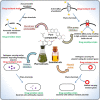Exploring Phytochemicals for Combating Antibiotic Resistance in Microbial Pathogens
- PMID: 34366872
- PMCID: PMC8334005
- DOI: 10.3389/fphar.2021.720726
Exploring Phytochemicals for Combating Antibiotic Resistance in Microbial Pathogens
Abstract
Antibiotic resistance or microbial drug resistance is emerging as a serious threat to human healthcare globally, and the multidrug-resistant (MDR) strains are imposing major hurdles to the progression of drug discovery programs. Newer antibiotic-resistance mechanisms in microbes contribute to the inefficacy of the existing drugs along with the prolonged illness and escalating expenditures. The injudicious usage of the conventional and commonly available antibiotics in human health, hygiene, veterinary and agricultural practices is proving to be a major driver for evolution, persistence and spread of antibiotic-resistance at a frightening rate. The drying pipeline of new and potent antibiotics is adding to the severity. Therefore, novel and effective new drugs and innovative therapies to treat MDR infections are urgently needed. Apart from the different natural and synthetic drugs being tested, plant secondary metabolites or phytochemicals are proving efficient in combating the drug-resistant strains. Various phytochemicals from classes including alkaloids, phenols, coumarins, terpenes have been successfully demonstrated their inhibitory potential against the drug-resistant pathogens. Several phytochemicals have proved effective against the molecular determinants responsible for attaining the drug resistance in pathogens like membrane proteins, biofilms, efflux pumps and bacterial cell communications. However, translational success rate needs to be improved, but the trends are encouraging. This review highlights current knowledge and developments associated challenges and future prospects for the successful application of phytochemicals in combating antibiotic resistance and the resistant microbial pathogens.
Keywords: antibiotics; antimicrobial; drug resistance reversal agents; efflux pumps; medicinal plants; multidrug resistance; phytomolecules.
Copyright © 2021 Khare, Anand, Dey, Assaraf, Chen, Liu and Kumar.
Conflict of interest statement
The authors declare that the research was conducted in the absence of any commercial or financial relationships that could be construed as a potential conflict of interest.
Figures
Similar articles
-
Tackling Multiple-Drug-Resistant Bacteria With Conventional and Complex Phytochemicals.Front Cell Infect Microbiol. 2022 Jun 30;12:883839. doi: 10.3389/fcimb.2022.883839. eCollection 2022. Front Cell Infect Microbiol. 2022. PMID: 35846771 Free PMC article. Review.
-
Inhibiting Bacterial Drug Efflux Pumps via Phyto-Therapeutics to Combat Threatening Antimicrobial Resistance.Front Microbiol. 2018 Dec 10;9:2990. doi: 10.3389/fmicb.2018.02990. eCollection 2018. Front Microbiol. 2018. PMID: 30619113 Free PMC article. Review.
-
Plant synthetic biology for producing potent phyto-antimicrobials to combat antimicrobial resistance.Biotechnol Adv. 2021 May-Jun;48:107729. doi: 10.1016/j.biotechadv.2021.107729. Epub 2021 Mar 9. Biotechnol Adv. 2021. PMID: 33705914 Review.
-
Combating Drug-Resistant Bacteria Using Photothermally Active Nanomaterials: A Perspective Review.Front Microbiol. 2021 Nov 12;12:747019. doi: 10.3389/fmicb.2021.747019. eCollection 2021. Front Microbiol. 2021. PMID: 34867863 Free PMC article. Review.
-
Phytochemicals: potential alternative strategy to fight Salmonella enterica serovar Typhimurium.Front Vet Sci. 2023 May 16;10:1188752. doi: 10.3389/fvets.2023.1188752. eCollection 2023. Front Vet Sci. 2023. PMID: 37261108 Free PMC article. Review.
Cited by
-
Trans-cinnamaldehyde-Biosurfactant Complex as a Potent Agent against Enterococcus faecalis Biofilms.Pharmaceutics. 2022 Oct 31;14(11):2355. doi: 10.3390/pharmaceutics14112355. Pharmaceutics. 2022. PMID: 36365173 Free PMC article.
-
Facing Resistant Bacteria with Plant Essential Oils: Reviewing the Oregano Case.Antibiotics (Basel). 2022 Dec 8;11(12):1777. doi: 10.3390/antibiotics11121777. Antibiotics (Basel). 2022. PMID: 36551436 Free PMC article. Review.
-
Benzyl isothiocyanate as an alternative to antibiotics? a comparative in vivo study using Pseudomonas aeruginosa infection as a model.PLoS One. 2024 May 16;19(5):e0303490. doi: 10.1371/journal.pone.0303490. eCollection 2024. PLoS One. 2024. PMID: 38753636 Free PMC article.
-
Mitigating digestive disorders: Action mechanisms of Mediterranean herbal active compounds.Open Life Sci. 2024 Apr 18;19(1):20220857. doi: 10.1515/biol-2022-0857. eCollection 2024. Open Life Sci. 2024. PMID: 38645751 Free PMC article. Review.
-
Lippia graveolens Essential Oil to Enhance the Effect of Imipenem against Axenic and Co-Cultures of Pseudomonas aeruginosa and Acinetobacter baumannii.Antibiotics (Basel). 2024 May 14;13(5):444. doi: 10.3390/antibiotics13050444. Antibiotics (Basel). 2024. PMID: 38786172 Free PMC article.
References
-
- Aires A., Marques E., Carvalho R., Rosa E., Saavedra M. (2013). Evaluation of Biological Value and Appraisal of Polyphenols and Glucosinolates from Organic Baby-Leaf Salads as Antioxidants and Antimicrobials against Important Human Pathogenic Bacteria. Molecules 18, 4651–4668. 10.3390/molecules18044651 - DOI - PMC - PubMed
-
- Alibi S., Ben Selma W., Ramos-Vivas J., Smach M. A., Touati R., Boukadida J., et al. (2020). Anti-oxidant, Antibacterial, Anti-biofilm, and Anti-Quorum Sensing Activities of Four Essential Oils against Multidrug-Resistant Bacterial Clinical Isolates. Curr. Res. Transl. Med. 68 (2), 59–66. 10.1016/j.retram.2020.01.001 - DOI - PubMed
-
- Althunibat O. Y., Qaralleh H., Al-Dalin S. Y. A., Abboud M., Khleifat K., Majali I. S., et al. (2016). Effect of Thymol and Carvacrol, the Major Components of Thymus Capitatus on the Growth of Pseudomonas aeruginosa. J. Pure Appl. Microbiol. 10, 367–374.
Publication types
LinkOut - more resources
Full Text Sources




